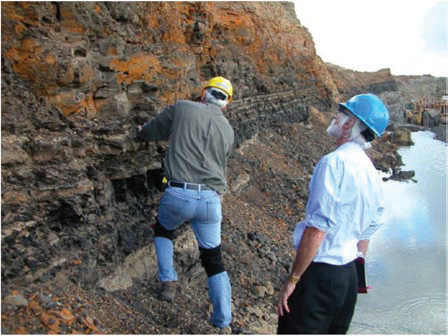Site: TransAlta Centralia Geologic Storage Site
Type: EOR/saline
Lat/Long
Centralia, Washington (46.717349, -122.958686 Regional)
Why This Location?
Options for conventional carbon dioxide (CO2) storage in saline formations are relatively less abundant in Washington and Oregon than in many other regions of the United States, such as the Gulf Coast or Midcontinent, where large structurally simple sedimentary basins containing saline reservoirs along with oil and gas reservoirs provide huge storage resources. However, one of the best candidates for largescale CO2 capture with geologic storage in the Pacific Northwest is near Centralia in west-central Washington state. The TransAlta Centralia site offered the potential for storage in the deep coal seams and the saline formations of the Centralia-Chehalis Basin combined with a potential source of CO2 from TransAlta’s 1,404-megawatt coal-fired power plant, a major source of CO2 emissions in the region. Data needed for the feasibility study was available from previous coalbed methane (CBM) studies in the region, as well as coal mining operations.
Main Research Q&As Discovered
The goals of the research at the TransAlta Centralia site were to evaluate the storage potential of deep coal seams and saline formations and assess the feasibility of a potential carbon dioxide (CO2)-enhanced coalbed methane (ECBM)/storage field pilot test. At the site, coal seams in the Skookumchuck Formation with CO2-ECBM potential were present at depths of 150 to 500 meters (approximately 492 to 1,640 feet) and totaled approximately 18 meters (59 feet) in thickness. Geologic mapping and analyses indicated that approximately 52 million metric tons of CO2 could be stored in the coal seams, equivalent to about 13 years of the (then) current emissions at 50% capture. West Coast Regional Carbon Sequestration Partnership (WESTCARB) researchers also found that some of the sandstones interbedded with the coals had good reservoir quality, with porosity as high as 30% and permeability of up to 3 darcies. Initial estimates indicated that the interbedded saline sandstones could store roughly approximately 38 to 292 million metric tons, adding 9 to 73 years of storage resource (at 50% capture). Uncertainties in storage resource estimates were high, particularly for the sandstones, due to limited data availability. Researchers also identified some geologic characteristics at Centralia which were potentially unfavorable for a CO2 storage project, including structural complexity from folding and faulting, relatively small size of coal deposits, and presence of igneous dikes and sills. It was concluded that a joint coal seam and saline formation test program, involving three to five coreholes, would be the next step to measure coal seam and saline formation reservoir properties at Centralia and better define their CO2 storage characteristics and potential.
Lessons Learned that Impacted Phase III Design?
The TransAlta Centralia site study illustrated the challenges in identifying and developing large-scale storage projects in areas where there are limited opportunities and experience in related subsurface engineering activities such as oil and gas production. The size of the coal deposits was smaller than expected from previous regional-scale studies. Similarly, previous studies had identified thick sedimentary sandstone layers in the basin, but most of these were found to have poor reservoir quality. However, as noted, some good quality sandstones were found interbedded with the coals, indicating the viability of a stacked storage project involving saline storage and carbon dioxide (CO2)-enhanced coalbed methane (ECBM). Given the uncertainties in reservoir quality and the geologic complexity of the site, it was concluded that a small-scale, joint coal seam and saline formation test program, involving three to five coreholes, would be needed in order to establish the feasibility of a large-scale Phase III project
Story of Interest
Carbon dioxide (CO2) storage in the deep coal seams, in conjunction with methane production (CO2-enhanced coalbed methane [ECBM]), is an option in the Pacific Northwest, where opportunities for conventional CO2 storage in saline formations are relatively less abundant. CO2-ECBM builds upon commercially available conventional coalbed methane (CBM) technology. Though there were no commercial CBM projects in the Centralia-Chehalis Basin, results of pilot CBM tests in the region were one of the motivating factors in undertaking the studies at the TransAlta Centralia site. Testing of saline formation storage was not part of the original plans. The unfavorable geologic characteristics at Centralia (strongly folded, faulted, and compartmentalized sediments) hindered the CO2-ECBM option, as they have hindered conventional commercial CBM production throughout the region. Discovery of good quality reservoir sandstones interbedded with the coals raised the concept of stacked storage, which had not previously been considered, to enhance storage. The implementation of a stacked storage project could be feasible in Washington state due to the routine permitting experience of CBM and gas storage operations, providing a potential regulatory pathway for advancing CO2 capture and geologic storage in the Pacific Northwest.
Geologist Rock-Fest Call Out
Studies at the TransAlta Centralia site, located near TransAlta’s power plant in Centralia, Washington, focused on characterization of interbedded coal seam and saline formation targets in the area. The interbedded coals and sandstones make the site a candidate for stacked storage. The Eocene Skookumchuck Formation coal seams contain extensive sub-bituminous rank coal deposits in the region. The coal-bearing formations in the project area were deposited in deltaic, fluvial, brackish, and shallow marine environments. Thick saline sandstone sequences also occur in the Eocene Cowlitz, Northcraft, and Skookumchuck Formations. The majority of these are of poor reservoir quality, comprising poorly sorted volcanic-derived sediments that have been hydrothermally altered with secondary chlorite, zeolite, and quartz mineralization. However, some Skookumchuck sandstones interbedded with the coals have high porosity and permeability, making them prime carbon dioxide (CO2) storage targets. Unfavorable geologic characteristics at Centralia that may hinder geologic storage include a complex geologic structure with strong folding and faulting and the possibility for active faults, the small size of the coal deposits, and the intrusion of the coals and sandstones by igneous dikes and sills.




